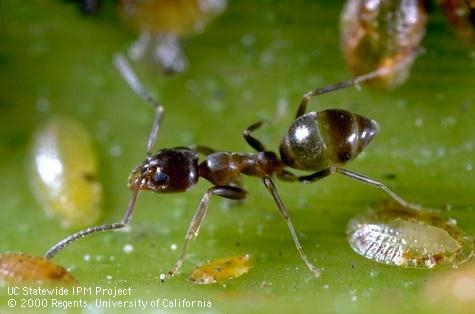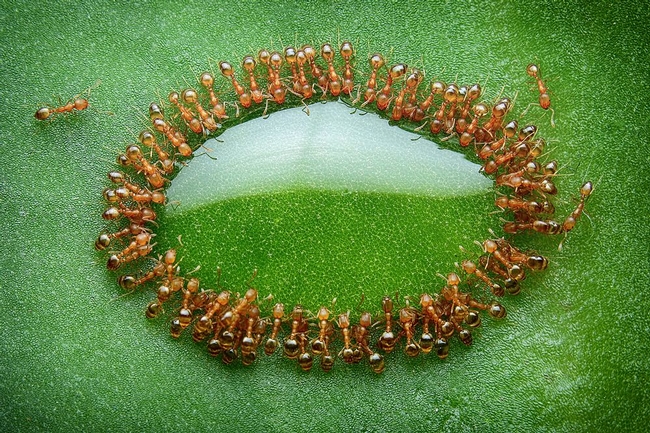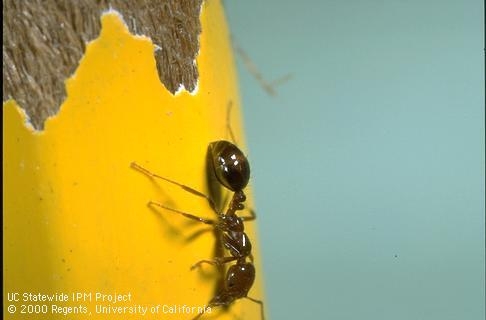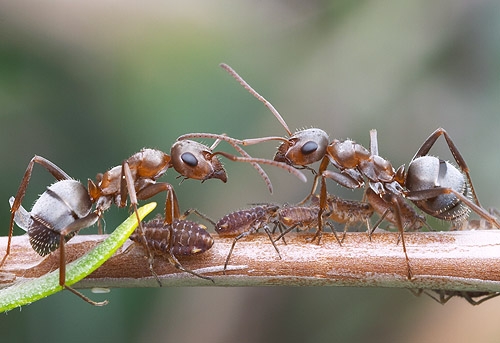Many growers seem like they will never win the never ending battle with ants, they're everywhere! Conversely, ants travel through soil and help loosen it improving quality, allowing water, air, and nutrients to flow freely through it. They also decompose dead plant and animal matter and can even feed on other insects. However, ants sometimes chew crop twigs and tender bark, damage irrigation tubing, and can annoy and harm workers. You can find ants traveling alongside your trees, the ground, or irrigation lines and build their nests underground.

The southern fire ant (Figure 2.) is light reddish brown with a black abdomen. Active in the morning and early evening and do not trail. May swarm out of nests if disturbed and can inflict painful stings.
Native gray ants (Figure 3.) are gray and considerably larger than the other two species. They nest in topsoil or under rocks and debris and move in irregular patterns. In contrast to Argentine and fire ants, the native gray ant is solitary and its importance in disrupting biological control is often underestimated. Red imported fire ant is new to California and can make large, dome-shaped mounds. They feed on almost any plant or animal material.
Avocados & Citrus
Ants are pests primarily because they disrupt biological control of other pests, especially that of the Tamarixia radiata, which is a natural predator for the Asian Citrus Psyllid. Ants are also a big problem in young trees causing trunk damage as well as feed on honeydew excreted by various soft scales, mealybugs, cottony cushion scales, whiteflies, and aphids. As part of this relationship, they also protect these insects from their natural enemies, thus interrupting biological control of the honeydew-producing pests. In the process of keeping most natural enemies away, they also protect other pests, such as California red scale, that profit from the lack of natural enemies. Argentine and native gray ants are the most common ant species that aggressively protect pest insects. In addition, Argentine ants and red imported fire ants can plug up irrigation sprinklers. Red imported fire ants directly damage plants by chewing twigs and tender bark of newly planted trees; they also sting people working in the orchard and may cause allergic reactions and sometimes trips to the emergency room.
For more information on ants in avocados, please visit the UC IPM website:
http://www.ipm.ucdavis.edu/PMG/r8301311.html.
For more information on ants in citrus, please visit the UC IPM website:
http://www.ipm.ucdavis.edu/PMG/r107300211.html.
Management
Ant management requires diligent efforts and the combined use of mechanical, cultural, sanitation, and often chemical control methods. Ant populations peak in mid-summer through early fall, therefore the best time to bait is late winter to early spring when ant numbers are relatively low. Bait effectiveness varies with ant species, availability of alternative food, active ingredient, type of bait, and the time of year. To determine which bait to use, offer a small quantity of each of several baits and observe which is preferred by the ants.
For information on ants in general, please visit the UC IPM website:
http://www.ipm.ucdavis.edu/PMG/PESTNOTES/pn7411.html.


